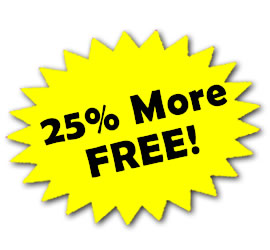What Pricing Strategy Beats Discounts?
 If you want to sell more product by running a sale, which would make more sense: advertising “price cut 33%” or “50% more” product? Functionally, the two are the same level of discounting. Researchers at the University of Minnesota found, though, that a “50% bonus pack” sold 71% more than a “35% discount,” even though the latter is a slightly lower price per unit.
If you want to sell more product by running a sale, which would make more sense: advertising “price cut 33%” or “50% more” product? Functionally, the two are the same level of discounting. Researchers at the University of Minnesota found, though, that a “50% bonus pack” sold 71% more than a “35% discount,” even though the latter is a slightly lower price per unit.
Our Brains Are Bad at Math
As Barbie famously said, “Math is hard.” Both male and female brains aren’t good at automatically determining which deal is best, which explains why a “50%” number looks more attractive than “35%” even when mathematically it is actually worse. The researchers call this “base value neglect” – in essence, we look at the percent without paying attention to the number to which the percent applies! (The paper appears in the Journal of Marketing and is titled When More Is Less: The Impact of Base Value Neglect on Consumer Preferences for Bonus Packs over
Price Discounts.)
Maximize Your Percent
The first takeaway is that you should always try to structure a promotion in terms of the biggest percent you can. (A “50% more” type approach may have the added benefit of carrying through more product.)
The paper notes that stacked discounts are also overestimated by consumers. So, “Take 25% more off” a price that is “discounted 25%” will seem larger than if the price is described as a “43% discount.”
Don’t Forget FREE!
Other research has shown that the word “FREE!” is a significant motivator for consumers – see The Power of FREE!. The Minnesota researchers were aware of this, so they eliminated the word “free” from their bonus offers to avoid distorting the effects of the subjects not paying attention to the base value.
You, on the other hand, should use FREE! whenever you can. Instead of “25% Bonus” or “25% More,” use “25% More FREE!” to maximize sales.
In short, combine the biggest percentages with the word FREE! and you’ll sell far more product than an equivalent discount.
